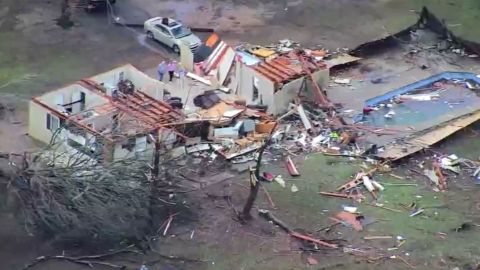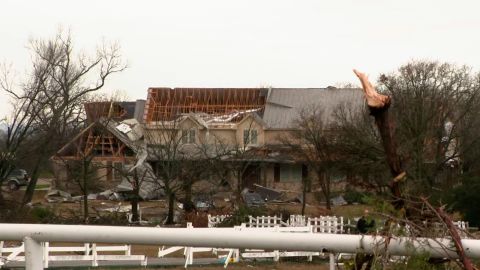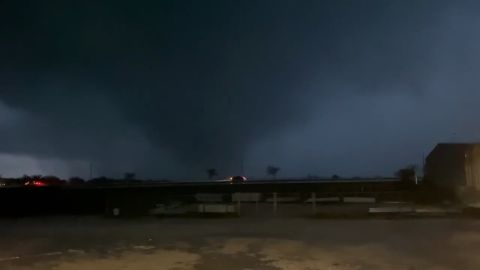[ad_1]
CNN
—
Severe storms including suspected tornadoes have carved paths of destruction in Oklahoma and the Dallas-Fort Worth area Tuesday and injured at least seven people – part of a larger storm system that threatens more damage in the South and blizzard conditions in states farther north.
The giant winter storm system is pushing through the central US after walloping the West. About 21 million people from Texas to Mississippi are under threat of severe storms Tuesday, including tornadoes. And about 14 million people – largely in the north-central US – are under winter-weather warnings or advisories Tuesday morning, with blowing snow and power outages a key concern.
A tornado watch is in effect for parts of Arkansas, southeastern Oklahoma and eastern Texas until 5 p.m. CT.
Damage on Tuesday includes:
• Grapevine, Texas: At least one tornado was reported in this city just outside Dallas Tuesday morning, the National Weather Service said, and storms left at least five people there injured, Grapevine police said. Details about the injuries weren’t immediately available.
Businesses including a Grapevine mall, a Sam’s Club and a Walmart were damaged, police said. A gas station was destroyed, and drivers on one road were forced to share a single lane because downed trees and other debris blocked parts of the thoroughfare, motorist Claudio Ropain David told CNN.
• Elsewhere outside Dallas: At least two people were injured, and homes and businesses were damaged, as severe weather hit east of Paradise and south of Decatur in Wise County on Tuesday morning, northwest of Fort Worth, county officials said.
One person was hurt when wind overturned their vehicle, and the other – also in a vehicle – was hurt by flying debris, the Wise County emergency management office said. One was taken to a hospital, the office said without elaborating.
High winds also damaged homes and trees near Callisburg north of Dallas, blew over tractor-trailers near the towns of Millsap and Weatherford; and damaged barns near the town of Jacksboro, the National Weather Service said.
• Wayne, Oklahoma: A suspected tornado in that town knocked out power and damaged homes, outbuildings and barns early Tuesday, officials said, adding no injuries were reported. Homes were flattened or had roofs torn off, and trees were snapped like twigs, video from CNN affiliate KOCO showed.

More severe storms capable of tornadoes are expected Tuesday and Wednesday in the Gulf Coast region as the complex snow-or-rain system sweeps through the central US from north to south.
Across the central and northern Plains and Upper Midwest, blowing snow and/or freezing rain into Thursday could snarl travel and threaten power outages.
Here’s what different regions can expect in the coming days:
• An “enhanced risk” for severe storms Tuesday stretches from eastern Texas through central Louisiana and into part of Mississippi, with tornadoes, large hail and damaging straight line winds possible.
• Blizzard conditions are expected Tuesday and Wednesday for parts of the central and northern Plains, with snow at times expected to fall at rates of 1 to 2 inches per hour amid powerful 40 mph winds.
• The greatest flash flooding threat will be Tuesday into Wednesday from the lower Mississippi Valley into the central Gulf Coast, Tennessee Valley and southern Appalachians.
• Freezing rain and sleet will be possible through Wednesday in the Upper Midwest.

The storm, which first hit the western US over the weekend with much-needed snow and rain, resulted in winter storm alerts from the Canadian border to Mexico’s border with New Mexico.
In Denver, up to 5 inches of snow are expected Tuesday, with 50 mph wind gusts possible.
Blizzard warnings extended Tuesday from parts of Montana and Wyoming into northeastern Colorado, western Nebraska and South Dakota, where harsh, life-threatening conditions are expected. A blizzard consists of at least three hours of sustained winds or frequent gusts at 35 mph or greater during considerable snowfall and conditions making for poor visibility.
Snowfall through Wednesday morning generally could be 10 to 18 inches in the central and northern Plains and Upper Midwest. Some areas inside the blizzard warning zones – particularly western South Dakota, eastern Wyoming and northwestern Nebraska – could get as many as 24 inches of snow, with winds strong enough to knock down tree limbs and cause power outages, the Weather Prediction Center said.
In Sidney, Nebraska, winds whipped Tuesday morning at 53 mph, CNN meteorologist Chad Myers said, “and then you add in the snow, visibility is a quarter mile.”
Interstates in South Dakota could become impassable amid the blizzard conditions, resulting in roadway closures across the state, the South Dakota Department of Transportation warned Monday.
Ice storm warnings were issued for parts of eastern South Dakota, southwestern Minnesota and western Iowa. Up to two-tenths of an inch of ice could accumulate in some of these areas, forecasters said.
In Anchorage, Alaska, an “unprecedented amount of snowfall” has led to schools being closed for four days and on Monday shut down the University of Alaska Anchorage and Alaska Pacific University.
“The snowstorms that have hit Anchorage over the last week are historic in nature, bringing anywhere between 30-45 inches of snow to our city,” said Hans Rodvik, a spokesperson for the Anchorage mayor’s office, said Monday in a statement to CNN.
Meanwhile, the southern end of the storm threatens to bring tornadoes.
An alert for enhanced risk of severe weather – level 3 of 5 – was issued Tuesday for eastern Texas and the lower Mississippi River Valley, with the main threats including powerful tornadoes, damaging winds, and large hail. Baton Rouge, Shreveport, and Lafayette, Louisiana, are part of the threatened area, as is Jackson, Mississippi.
“My main concern with the tornadoes is going to be after dark,” Myers said Tuesday. “We have very short days this time of year, so 5 or 6 o’clock, it’s going to be dark out there. Spotters aren’t as accurate when it is dark. Tornado warnings are a little bit slow; if you’re sleeping, you may not get them. So, that’s the real danger with this storm.”

A zone of slight risk – level 2 of 5 – encircled that area, stretching from eastern Texas and southern Oklahoma to southern Arkansas and much of the rest of Louisiana, including New Orleans, and central Mississippi.
Tuesday also brings a slight risk of excessive rainfall in parts of Arkansas, Louisiana and Mississippi, with 2 to 4 inches of rain and flash flooding possible, the Weather Prediction Center said.
On Wednesday, the threat for severe weather is largely focused on the Gulf Coast, with tornadoes and damaging winds possible over parts of southern Louisiana, Mississippi, southwest Alabama and the western Florida Panhandle, the Storm Prediction Center said.
Source link



